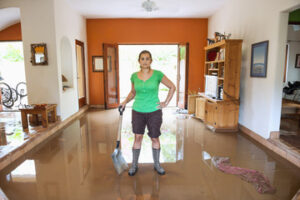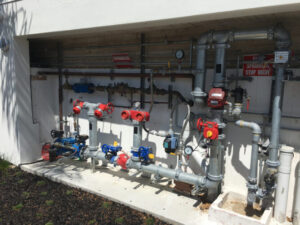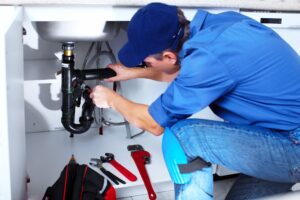Water damage can be imperceptibly slow such as water spots marring surfaces, or it can be sudden and catastrophic like flooding. Whatever the cause, it can cost homeowners and insurance companies a lot of money.

Unexplained humidity and dampness can be indicative of an undetected water leak. Checking your washing machine and refrigerator hoses regularly can prevent this.
Water tanks are essential for collecting and holding rainwater or well water, providing emergency drinking water in the event of a natural disaster, and for various commercial applications. While these tanks are designed to withstand the elements and resist corrosion, it is not uncommon for damage to occur over time. Water tank repair and maintenance are important to ensure your water is safe for consumption.
Water storage tanks are usually located in potentially extreme environments that see large shifts in weather, high winds, and other wear and tear from the elements. This is why they need regular inspections, testing and maintenance to spot small cracks or deterioration before they grow into serious problems.
One of the most common types of water tank damage is a leak. Leaks from water tanks are caused by cracks, mineral deposits, corrosion and other environmental factors. Leaks can result in contaminated water, which is dangerous for consumption and can lead to serious health issues. The good news is that most leaks can be fixed with minor repairs or replacement parts.
Another type of water tank damage is a fire. The heat from a fire can melt plastic tanks, warp metal ones and destroy the interior plastic lining of concrete tanks. While it is rare for a fire to completely destroy an elevated water tank, it is possible to have a significant amount of water loss as a result.
Lastly, erosion and sediment build-up can also cause damage to water tanks. As the water in a tank evaporates, it leaves behind sediment which can be a breeding ground for bacteria and pathogens. These bacteria and pathogens can then contaminate the water stored inside of the tank. Regular water tank cleaning and disinfection can prevent this from happening.
A simple way to check your water tank for damage is to use a candling technique. This involves shining a light inside of the tank to help detect holes and cracks. To do this, get one person to look into the tank’s fill neck or manhole while blocking light from coming into the access hatch around their body. The light inside of the tank will shine through any cracks or holes, making them easier to see.
Water Supply Line Breaks
A water line that brings freshwater from a municipal main to your home can break for many reasons. Age is a factor, but also soil erosion can play a role. Clay soil can develop corrosive conditions that damage pipes over time, and sudden shifts in the ground can damage underground piping. Local construction projects can also cause sudden changes in water pressure that stress piping systems.
One of the earliest indicators of a water line break is low water pressure from all home sources. This usually means the pipe is clogged, but it can be a sign of a bigger problem. Another warning sign is noticing that your water has become discolored. The water department will often issue boil water advisories if they suspect contaminated water is entering the supply lines. This is because dirt and rust may be seeping through the cracked piping into your home’s water.
Once you have determined there is a leak, it’s important to shut off any appliances that use water. You should also close the main water valve in your home until the leak has been repaired. If you have a sprinkler system, you’ll want to turn it off as well. This will help prevent any further damage to your property.
Ideally, you should have a plumber come out right away to fix the water line break. However, if you’re handy with a toolbox and have a bit of experience, you can replace the section of pipe yourself. First, drain the affected area of your water line. Next, you can remove the old piece of pipe by unscrewing it from the fitting. You’ll want to be careful, though, as you will need to shield wooden ceiling joists, wires, and anything else flammable before you start working.
Once you’ve removed the old piece of pipe, cut a length of copper tubing that matches the size of your broken pipe and connect it to the new piece of tubing with solder. You can use a soldering kit that comes with a torch and solder to make the connection, or you can try it yourself using the same method as plumbing repairs for a garden hose. Just be sure to use a flame protector cloth, and always keep a bucket of water nearby.
Appliance Leaks
While most people associate water damage with severe storms or melting snow, a more common cause of water damage is appliances that leak. Many household appliances that require a water connection, including the dishwasher, refrigerator, washing machine and air conditioner, are at risk for sprouting a leak. Even a small drip can lead to extensive water damage over time. The resulting moisture can damage flooring, create wood rot and drywall, and increase the likelihood of mold growth.
A homeowner can help prevent appliance-related water damage by regularly checking their appliances for signs of leaks. Look for damp spots on walls, saggy floors and other structural damage, moldy or musty odors that won’t go away, and puddles of water around the appliance. Inspect the appliance’s hoses and connections for cracks or breaks, discoloration of the hose or pipes, rust on the appliances or corroded fittings.
Whenever you suspect that an appliance is leaking, shut off the appliance and call a professional specializing in appliance repair. If possible, the pro can inspect the appliance and repair it before extensive water damage occurs.
If you’ve discovered that a home appliance has caused water damage, it may be worth filing a home insurance claim. While some homeowners are hesitant to do so, a professional insurance broker can help the claims process go smoothly and ensure that you receive a fair settlement.
While a homeowner can help prevent most appliance-related floods and leaks, not everyone has the luxury of routinely inspecting their home for potential problems. For those who want to protect their home, a trusted home service provider like NYTDR can provide preventative maintenance services and help homeowners file a successful water damage claim. Contact us to learn more about our professional repair and restoration services. We’re available 24/7 to respond to emergency situations. We also offer free water damage estimates. Call today to get started! We’re proud to serve customers in Billings, MT, and surrounding areas.
Homeowner’s Insurance
Homeowner’s insurance is designed to help pay for repairs or replacement of damaged property. It can cover structural damage, personal belongings and loss of use. However, the exact details of homeowners insurance will vary by insurer and policy type. To ensure that you have the most coverage possible, make sure you read your policy carefully. Water damage is a common cause of property losses. But not all types of water damage are covered by standard home insurance policies.
Generally, the most common causes of water damage are a burst pipe or flooding. These incidents can be devastating to homes and families. But other causes are less common and may not be covered by standard homeowner’s insurance.
For example, a clogged or broken sewer system or sump pump may result in sewage backing up into the house and causing serious health problems. Such issues are usually not covered by standard homeowners’ insurance, but a supplemental policy might include this as an additional option for coverage.
It’s important to be proactive about maintenance of your appliances and pipes. Follow the manufacturer’s recommendations for maintenance and have regular inspections by a licensed plumber. This can prevent leaks or water damage from occurring. When they do, act quickly to make the necessary repairs. Document the damage with photos or videos and keep receipts to submit for claim reimbursement.
You should always review your policy and discuss any questions or concerns you have with an insurance agent. You can also work with an attorney if you believe that your insurance company has acted in bad faith.
Homeowner’s insurance generally includes dwelling coverage, personal property coverage and loss of use coverage for water damage. Dwelling coverage will typically cover structural damage, while personal property and loss of use coverage will both pay for possessions and cost to live elsewhere if necessary. Depending on your specific policy, you may have actual cash value or replacement cost coverage for your possessions. Replacement cost will reimburse you for the item at today’s prices, while actual cash value pays you only what the item was worth when it was first purchased.


